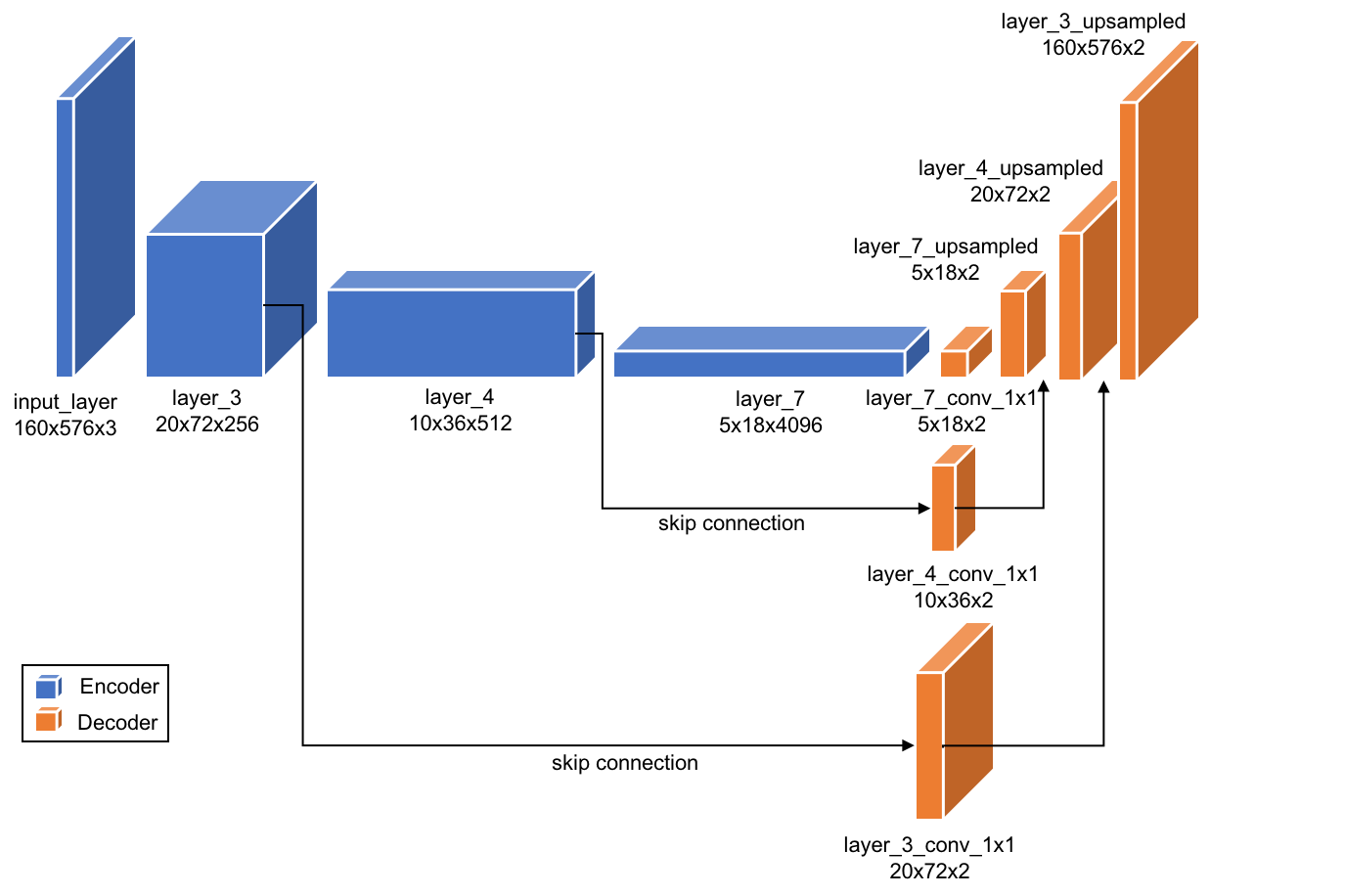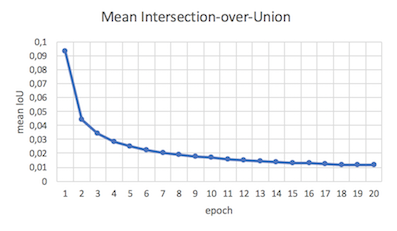Project 12: CarND-Semantic-Segmentation-Project
Introduction
In this project, the goal is to label the pixels of a road in images using a Fully Convolutional Network (FCN) as described in the paper Fully Convolutional Networks for Semantic Segmentation by Jonathan Long, Evan Shelhamer, and Trevor Darrell from UC Berkeley. The projects is based on Udacity's starter project.
The following image shows exemplarily the result of the VGG-16 based FCN which has been trained to determine road (green) and non-road (not marked) areas.
Fully Convolutional Network (FCN) Architecture
The Fully Convolutional Network (FCN) is based on a pre-rained VGG-16 image classification network. The VGG-16 network acts as a encoder. In order to implement the decoder, I extracted layer 3, 4 and 7 from the VGG-16 (main.py line 80) network and implemented several upsampling and skip connections (main.py line 102). The image below shows the schematic FCN architecture. The blue boxes represents the VGG-16 encoder and the orange boxes the added decoder layers.
layer_7_conv_1x1: conv2d(kernel_size=1, strides=1)layer_7_upsampled: conv2d_transpose(kernel_size=4 and strides=2)layer_4_conv_1x1: conv2d(kernel_size=1, strides=1)layer_4_upsampled: conv2d_transpose(kernel_size=4 and strides=2)layer_3_conv_1x1: conv2d(kernel_size=1, strides=1)layer_3_upsampled: conv2d_transpose(kernel_size=16 and strides=8)
Each convolution conv2d()and conv2d_transpose() has been setup with a kernel initializer (tf.random_normal_initializer) and a kernel regularizer (tf.contrib.layers.l2_regularizer).
Training on AWS EC2 Instance
The FCN has been trained on an Amazon Web Services (AWS) EC2 g2.2xlarge instance with the following hardware configuration.
- 8 vCPUs (Intel Xeon E5-2670)
- 1 GPU (NVIDIA 1536 CUDA processor with 4 GB video RAM)
- 15 GB RAM
- 60 GB SSD
To setup the EC2 instance with python v3.5.2, tensorflow v1.4 and all dependencies, I created an anaconda environment file environment.yml which creates the carnd-term3 environment.
The following command prepares the anaconda environment:
conda env create -f environment.yml
The install_data.sh script downloads the pre-trained VGG-16 network and the KITTI road dataset. Now everything is prepared to start the training.
Training Set
As training set I used the Kitti Road dataset from here. It consists of 289 training and 290 test images. Furhter details can be found in the ITCS 2013 publication from Jannik Fritsch, Tobias Kühnl, Andreas Geiger.
| abbreviation | #train | #test | description |
|---|---|---|---|
| uu | 98 | 100 | urban unmarked |
| um | 95 | 96 | urban marked |
| umm | 96 | 94 | urban multiple marked lane |
| URBAN | 289 | 290 | total (all three subsets) |
Hyper-Parameters
Due to the limited video RAM the batch size has been limited to 2. The total training time for 289 training samples took 1h and 18 min for 20 epochs.
| Parameter | Value |
|---|---|
| KERNEL_INIT_STD_DEV | 0.001 |
| L2_REG | 0.00001 |
| KEEP_PROB | 0.5 |
| LEARNING_RATE | 0.0001 |
| EPOCHS | 20 |
| BATCH_SIZE | 2 |
Cross Entropy Loss and IoU - Intersection-over-Union
In order to find the best model, I saved the trained model after each epoch and observed the cross entropy loss and IoU (Intersection-over-Union) values. The IoU values are calculated in the main.pyin line 180.
As depicted in the two diagrams below the cross entropy loss value increased drastically after epoch 18 whereby the IoU value saturates. Therefore, I choose the trained model after epoch 18.
Tensorboard
In order to visualize the FCN graph, the cross entropy and intersection-over-union progress I added several summary operations into the model and training methods. All relevant TensorBoard log files are stored in the tensorboard_log directory. The TensorBoard can be started with the following command.
tensorboard --logdir=tensorboard_log/
Results
The FCN classifies the road area quite well. It has some trouble to determine the road area in rail sections or in scenes with heavy cast shadows. This is due to the fact, that the training set with only 289 images is very small and not all scenarios in the test set are covered by the training set. By applying bigger training sets or image augmentation the performance could be further improved.





